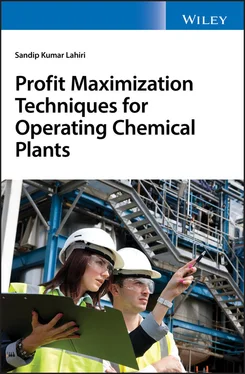Genetic Programing for Modeling of Industrial Reactors
Industrial reactors are the most potential candidates used to increase profit, yet they are the most neglected in the optimization project in industry. This is due to fear of process engineers to change reaction parameters beyond their usual boundaries because of poor knowledge of reaction kinetics. Conventional methods for evaluating complex industrial reaction kinetics have their own limitations. Chapter 13introduces a completely new advanced computational technique, namely geometric programing (GP), to model industrial reaction kinetics. Being a new computational technique, the main advantage of GP is that process engineers do not have to assume any form of kinetic equation beforehand; it will be generated on its own from available industrial reactor data. The theoretical basis of GP with its various features, an algorithm of GP, and different case studies are discussed in detail to enlighten the reader about this new technique. How a generated kinetic model can be used online and offline to increase profit from an industrial reactor is described in detail through case studies.
Maximum Capacity Test Run and Debottlenecking Study
All over the world, chemical plants are running 100–140% of their installed nameplate capacity. Profit maximization by capacity enhancement is a very common route in process industries. This high capacity running more than their design capacity is possible due to inherent safety margins available in process equipment. This chapter helps readers to understanding different safety margins available in process equipment and explains the strategy to exploit those margins. Chapter 14explains in a systematic way how to increase plant capacity without affecting safety and reliability. Plant real bottlenecks and the potential opportunity to increase capacity can be evaluated by actually performing a demo test run of the plant with the highest possible capacity for one week, which is commonly known as a maximum capacity test run. Fourteen key steps to carry out a maximum capacity test run in commercial running plants is the key focus area of this chapter. All the steps of the maximum capacity test run are explained with real‐life examples and industrial case studies. The next step of the maximum capacity test run is to find real bottlenecks of the plant by a debottlenecking (DBN) study. How to carry out a DBN study from the existing data and its different aspects are discussed in this chapter.
One of the strategies of profit maximization is to reduce the wastage of resources. In other words, this essentially means to minimize all the money drain from the plant. Chapter 15enlightens the reader about various strategies used to reduce the losses and wastages. A step‐by‐step procedure for a money loss audit is explained in detail in this chapter.
Advance process control (APC) already established itself as an effective tool to increase profit by pushing the process at its constraints. What is APC, how APC brings benefits, a candidate for APC implementation, and typical benefits obtained from commercial APC applications across the world are the subjects described in Chapter 16to enlighten a new reader about the potential of APC. A step‐by‐step procedure to build an effective APC application is discussed in detail. Special emphasis is given to describe the most important step, namely the functional design step. Do's and Don'ts of APC application buildings are explained so that readers are aware how to develop a robust application.
150 Ways and Best Practices to Improve Profit in Running a Chemical Plant
There are a million ways to increase profit. Leading refineries, petrochemicals, and chemical companies around the world have developed some best practices on their journeys for continuous improvement. These best practices are not confined to some process area and discipline, but are in diverse fields. The author has visited many fortune 500 chemical companies around the world and collected a list of these best practices. Due to brevity, only some of the high‐impact best practices are shared here. Leading chemical companies had discovered these best practices as part of their learning experience spanning over decades. When they implemented these best practices in their plants, they found huge profit improvements. Chapter 17gives an overview of 150 best practices followed by leading process industries around the world. All of the best practices discussed here are implemented and followed by some of the leading companies.
The practicing process engineers or production engineers working in chemical plants normally have much less exposure or knowledge to implement a site‐wide holistic profit maximization project. The available books on the market on chemical engineering and process engineering do not cover the practical aspects of how to increase profit in a running commercial chemical plant. The available books on chemical engineering optimization and energy improvement place emphasis on unnecessary theoretical details, which normally are not required by practicing engineers and those theories have very little relevance for commercial implementation of profit maximization in a running plant. Most of the books cover theoretical aspects and unnecessary detailed calculations mainly for the design of process equipment. Few books address optimization in chemical plants as their focus is on development of a superior theoretical optimization algorithm and completely ignore the real‐life application side. Every CEO in chemical plants understands that profit maximization in running a chemical plant is a vast subject and should be tackled holistically. There are various ways and means with varying degrees of usefulness to increase profit in operating plants. Profit can be increased by reducing waste, by optimizing processes, by increasing equipment performance, by improving reaction selectivity/yield/efficiency, by reducing raw material and utility consumption, by pushing the process towards its constraints, by running the plants at the highest possible capacity, by installing low‐cost high‐efficacy equipment, etc. Most of the available books cover the whole subject only partially. Some books cover energy optimization, some deal with waste minimization, and some introduce low‐cost design of equipment. However, no book is available on the market to cover the whole gamut of the subject holistically and in this context this will be the first such book. It provides engineers with all practical aspects of the profit maximization project in running plants, as well as expert guidance on how to derive maximum benefits from running the plants.
Clearly, it was not a small effort to write the book, but the absence of such a practical oriented book on the market and its requirement in a large number of process industries spurred me to writing it. I had an opportunity to work with leading petrochemical plants across the globe in the last 28 years was fortunate to see a wide spectrum of profit improvement initiatives taken by various fortune 500 companies. I have tried to incorporate all my learning and global experience in this book. I would like to thank Mr Mansoor Husain of M/s Scientific Design, USA, for teaching and exposing me to the practical field of profit improvement.
Finally, I am truly grateful to my family, my wife Jinia and my two lovely children Suchetona and Srijon, for their understanding and generosity of spirit in tolerating my absence during the writing of this book.
Dr Sandip Kumar Lahiri
January, 2020
1 Concept of Profit Maximization
1.1 Introduction
There has been a drastic change of business environment in the last 20 years. Shrinking profit margins in chemical process industries (CPIs) due to globalization and an uneven level playing field in international chemical businesses have given rise to cut‐throat competition among process industries and has changed the global chemical business scenario (Lahiri, 2017b). Introduction of low cost technology in the market, cheap oil prices, a decline in the growth rate of Chinese and EU economies, the recent discovery of cheap US shale gas, for example, have added new dimensions in the business environment in recent years.
Читать дальше












